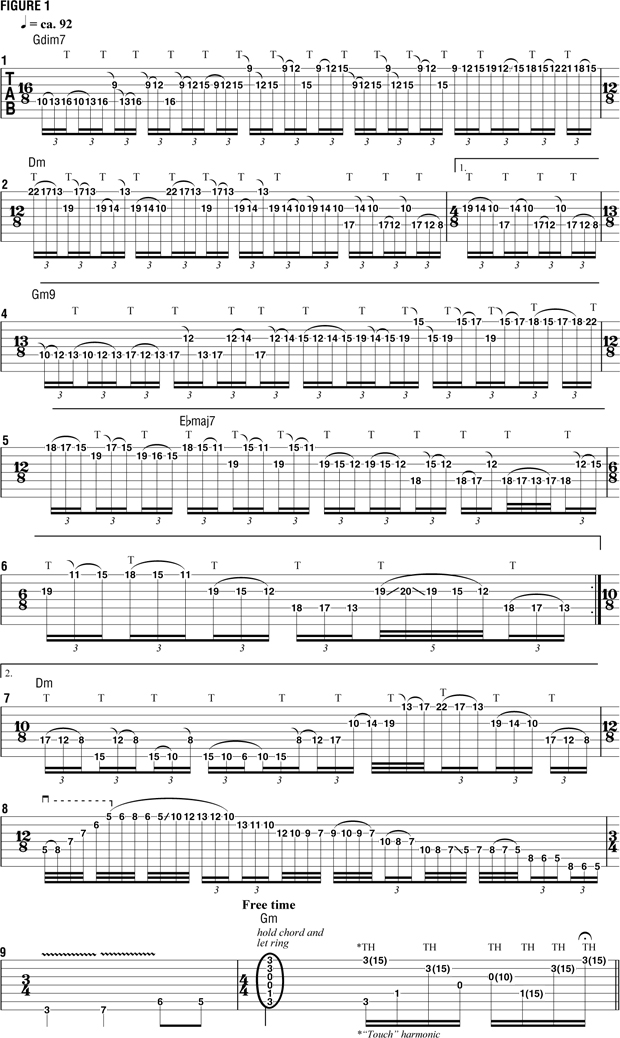Adapting Keyboard-Style Arpeggios to Fretboard Tapping, Part 2

This lesson is taken from the August 2010 edition of Chris Broderick's Guitar World column, "Chaos Theory."
Last month I introduced an original composition that involved the use of quickly played arpeggios, as well as utilized two-hand tapping techniques to emulate the way in which classical pianists play fluid-sounding arpeggios across multiple octaves.
This month’s example, which is part two of the same piece, continues in a manner similar to last month’s excerpt, with sequences consisting of steadily ascending four-note groups, i.e., each successive group begins one note higher in the arpeggio.
Let’s begin by looking at what is essentially the second half of the piece, illustrated in FIGURE 1. In bar 1, all the notes are based on a Gdim7 (G diminished seventh) arpeggio (G Bf Df E). After playing the first three notes, G Bf Df, I turn this into a four-note Gdim7 arpeggio and then repeatedly invert it by starting one note higher in the sequence each time. Notice that as the sequences progress, I use fret-hand “hammer-ons from nowhere”—sounding notes by firmly tapping a fret-hand finger onto a given string.
While the melody ascends in four-note patterns, it is phrased with the “feeling” of eighth-note triplets, with a 16th-note triplet played on each eighth note of the eighth-note triplet. Across the last beat and a half of bar 1, for the sake of varying the contour of the phrasing, I switch from four-note patterns to four groups of three-note patterns.
I return to four-note groupings in bar 2, based here on a Dm arpeggio (D F A) with the highest note doubled an octave lower, and descend the fretboard. During these descending arpeggios, the pick-hand tap always initiates the shift to notes sounded on a lower string. Notice also that I always jump two strings when switching to the next pick-hand tap. These four-note groups continue to descend through bar 3, bringing us into bar 4, which initiates a recap of the tapped Gm9 arpeggios (G Bf D F A) played in part one of the piece.
On beat one of bar 5, I switch to a straight scalar descent down G harmonic minor (G A Bf C D Ef Fs) and move to Efmaj7 (the Neapolitan chord in D minor) and descend through a series of four-note arpeggios based on Efmaj7 (Ef G Bf D). I then return to the Gdim7 arpeggios at the start of this excerpt and repeat bars 1 and 2 of FIGURE 1, and move to the second ending, which continues the four-note arpeggiations of Dm, descending and then ascending, through four octaves.
In bar 8 I return to conventional picking with a Dm sweep arpeggio, followed by fast alternate-picked phrases based on the D Aeolian mode (D E F G A Bf C). I change things up harmonically in bar 9 by playing a D major arpeggio (D Fs A), which serves as a V (five) chord to set up a resolution back to Gm, which ends the piece in bar 10.
While sustaining the Gm chord, I sound “touch” harmonics by lightly placing the fingers of my picking hand on certain strings exactly 12 frets above the fretted notes, and plucking the string simultaneously.

Get The Pick Newsletter
All the latest guitar news, interviews, lessons, reviews, deals and more, direct to your inbox!
“There are so many sounds to be discovered when you get away from using a pick”: Jared James Nichols shows you how to add “snap, crackle and pop” to your playing with banjo rolls and string snaps
Don't let chord inversions bamboozle you. It's simply the case of shuffling the notes around







![Joe Bonamassa [left] wears a deep blue suit and polka-dotted shirt and plays his green refin Strat; the late Irish blues legend Rory Gallagher [right] screams and inflicts some punishment on his heavily worn number one Stratocaster.](https://cdn.mos.cms.futurecdn.net/cw28h7UBcTVfTLs7p7eiLe.jpg)


